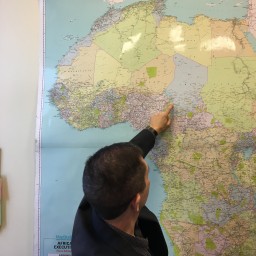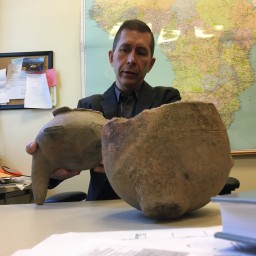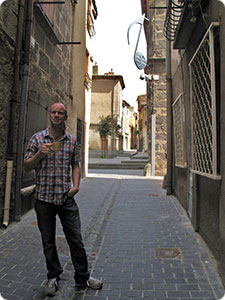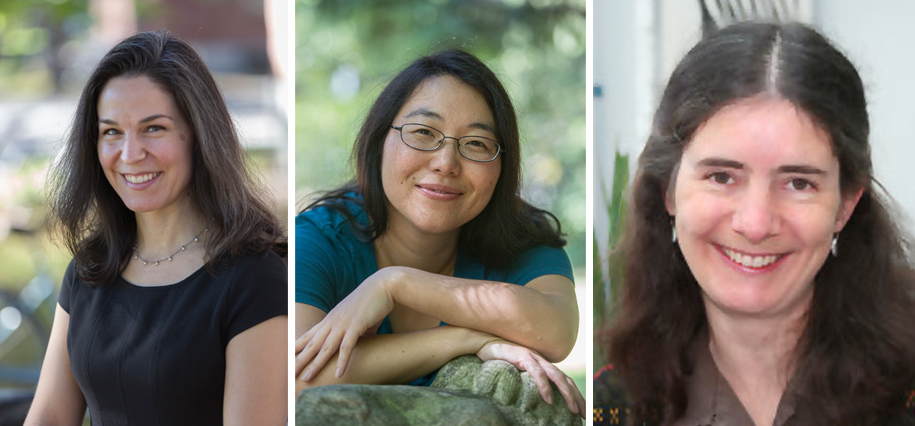Analyzing African Pottery: Archaeology Meets Math in Groundbreaking Collaboration
By Tom Porter
Archaeologist Scott MacEachern remembers with fondness the days when nobody used to know where he worked. For the last 30 years he has been a regular visitor to an area of west-central Africa known as the Lake Chad Basin, where the modern frontiers of Cameroon, Nigeria, Niger and Chad meet. “But unfortunately many people now do know where I work. The reason? Well you know the Boko Haram terrorist group? That’s exactly where it operates,” MacEachern said.
In this region, MacEachern, a Professor of Anthropology at Bowdoin, specializes in the study of ethnicity in Iron Age Africa. “There’s very little recorded history about the mountainous area I work in,” he explained, “so what we find in the ground is all we have to go on in trying to piece together a narrative.
“The last time I was there was in 2011, said MacEachern, “and we were only five miles from what is now a Boko Haram stronghold in Nigeria. That particular area is now off-limits for the time being, as you would expect, and the 2014 fieldwork was moved about 130 miles to the south for security reasons.” Nevertheless, over the previous two decades MacEachern and his team had excavated a huge amount of pottery from several large mound sites in the Lake Chad Basin. “We collected literally tons of pottery, most of it in broken fragments, known as potsherds. In all, nearly 300,000 potsherds were cataloged, complete with locational and decorative information. “Using radio carbon dating on the deposits they were found in, the potsherds were found to vary in age between 500 and 3,200 years old.”
Video by Rebecca Goldfine
With a dataset this huge, MacEachern figured a collaboration with his colleagues in the math department might be a good idea. Enter Jack O’Brien, Assistant Professor of Mathematics: “I’m an applied statistician, so constantly asking people for their data is pretty much an occupational hazard.” Most folks’ data, he said, have more complex patterns than they make use of, “so it’s always interesting to try to think of new ways to reframe data in ways that are going to help people’s research.”
Over the Spring 2015 semester, O’Brien enlisted math major Kathryn Lin ’15 to help analyze and interpret the results. “I was excited by the tangibility of Scott’s data,” said Lin, ” Each data point, after all, corresponds to a specific pottery sherd that was intentionally crafted by a person from a different time.” During one of her early meetings with MacEachern, Lin says he showed her a few potsherds that he had in his office. “I remember holding one of these sherds and being blown away by the volume of physical data that I would be analyzing.”

Archaeologists traditionally use a technique called cluster analysis. According to O’Brian this method has had some notable successes “but leaves a lot to the user to make determinations, and is not great at discerning patterns on its own.” O’Brien and Lin treated MacEachern’s dataset using a statistical method often used in genetics research, a technique which O’Brien said allows for much greater sensitivity than traditional cluster analysis. “The key insight was realizing that you could treat pottery distributions the same way you could treat microbial distributions, which is the sort of cross-disciplinary perspective that a place like Bowdoin naturally encourages.”
So what did the mathematicians discover that wasn’t possible using previous methods? “Perhaps the most interesting thing we can see,” said professor O’Brien, “is patterns of ethnic segregation at the most complex site which could be 1,000 years old.” For archaeologist Scott MacEachern, the discovery of what look like different “neighborhoods” at the site, dating back a thousand years or more, was a cause for excitement. “It makes sense historically given what I know about the region, so to see them there in the data is really, really interesting.”

Archaeologist often work with big datasets, said MacEachern, and they sometimes work with statisticians to help make sense of the those data. “But this is the first time I’ve used this particular approach.” The collaboration was also a new experience for professor Jack O’Brien and senior Kathryn Lin, who has since graduated. O’Brien said he wants to pursue this new, interesting line of research: “Scott and I are looking into inviting other archaeologists who work with similar data in Africa to see if we can infer things like migration or trade patterns.”
Professor Scott MacEachern said one factor that may hold back such research projects in the future is a shortage of archaeologists. “I tell my students there’s no shortage of archaeology, just archaeologists. For example I”m the only one actively working in the entire Lake Chad Basin.” And that, he said, is an area where an immense of material remains in the ground, waiting to be excavated, terrorist groups like Boko Haram notwithstanding.
Professors Scott MacEachern and Jack O’Brien, along with Bowdoin graduate Kathryn Lin, have published a paper about their collaborative project in the latest “Proceedings of the Royal Society B.”



